OceanStor eBackup日常维护手册
- 格式:pptx
- 大小:1.02 MB
- 文档页数:30

日常维护工作手册一.HIS系统各主机的登陆及日常巡检1.日常巡检巡检过程包括5个部分:检查errpt报错日志、检查换页空间使用率、检查文件系统使用率、检查ha状态、、检查各主机CPU/内存使用率。
登陆主机一errpt 软硬件报错 1 # hostname ---确认登陆主机2 #errpt –dH | more ---查询硬件错误(一般同时前面板黄灯)3 #errpt –aj xxxxxxx 查看详细的错误代码二检查换页空间使用率1 #Lsps –a --查看换页空间使用,内存足够时,使用率不高于5% 如果遇到换页空间增涨,可通过topas,vmstat等命令检查各进程状态,立刻通知应用工程师。
三检查文件系统使用率 1 #df –g 查看文件系统使用率如果有超过80%的文件系统,需要进入该目录,du –sm 查询那个目录或者文件较大。
四检查ha状态登陆主机# cd /usr/sbin/es/cluster#./clostat –a查看双机状态为stale 表示稳定如果出现网络故障网卡处显示为down五检查各主机CPU/内存使用率使用Topas vmstat 检查主机负载1. 关于topas命令的输出:右边从上至下依次是当前CPU、网络、磁盘使用情况和当前占用CPU资源较高的CPU使用情况一栏中有四项依次是kernel。
(此代表当前系统内核使用的CPU资源) User (此项是当前系统中其他用户使用的CPU资源)Wait (CPU等待时间)以及Idle (CPU空闲时间)。
Idle值很低的话,则代表当前CPU 十分繁忙。
在topas输出右侧的memory、paging space中可以查看当前系统内存与换页空间使用率。
2. 关于vmstat的输出:Proc部分:r-->在运行队列中等待的进程数。
(如此值达到2~5倍CPU数,说明系统中等待执行的线程数较多,可能存在性能问题)b-->在等待io的进程数memory部分:avm-->等于当前使用的物理内存和使用的交换区的总和减去作为文件系统缓存的物理内存(单位为4KB)free-->空闲的内存(4k表示)pages部分:re--》回收的页面pi--》进入页面数po--》出页面数fr--》代表此段时间内,有多少不用的物理内存被释放sr--》通过时钟算法扫描的页面fault 显示每秒的中断数:in--》设备中断sy--》系统中断cs--》cpu交换cpu 表示cpu的使用状态:us--》系统中用户操作所占用的CPU时间百分比sy--》系统中系统调用所占用CPU时间百分比id--》cpu空闲的时间百分比wa--》系统等待磁盘IO所占时间百分比(此时CPU闲置)LABEL 事件的预定义名称IDENTIFIER 事件的数字标识符Date/Time 事件的日期和时间Sequence Number 事件的唯一编号Machine ID 系统处理器部件的标识号Node ID 系统的缩写名(助记名)Class 错误的一般原因。
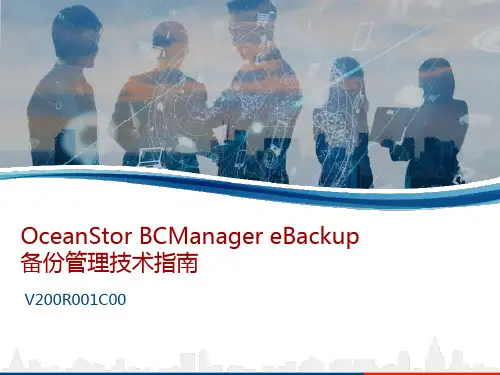
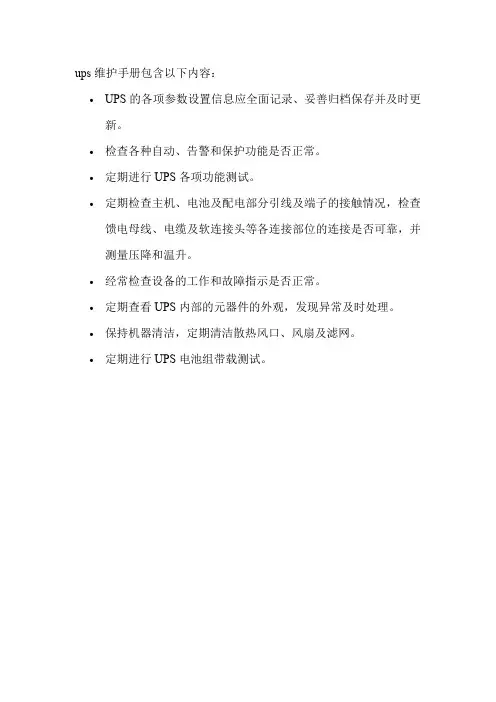
ups维护手册包含以下内容:
•UPS的各项参数设置信息应全面记录、妥善归档保存并及时更新。
•检查各种自动、告警和保护功能是否正常。
•定期进行UPS各项功能测试。
•定期检查主机、电池及配电部分引线及端子的接触情况,检查馈电母线、电缆及软连接头等各连接部位的连接是否可靠,并测量压降和温升。
•经常检查设备的工作和故障指示是否正常。
•定期查看UPS内部的元器件的外观,发现异常及时处理。
•保持机器清洁,定期清洁散热风口、风扇及滤网。
•定期进行UPS电池组带载测试。

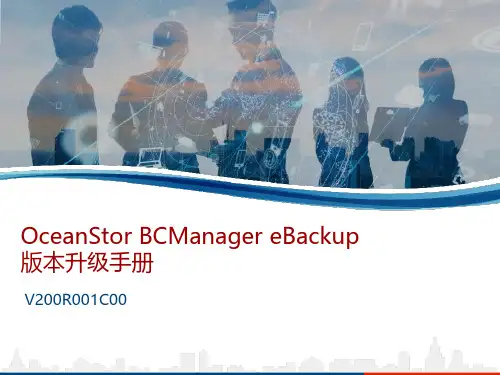
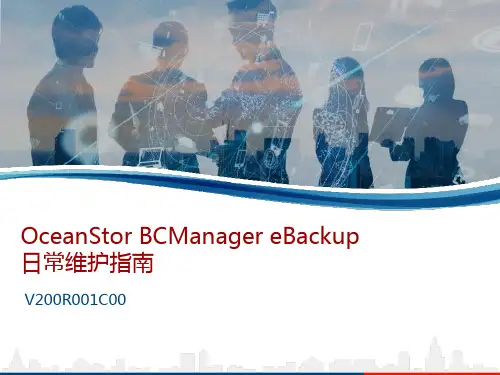
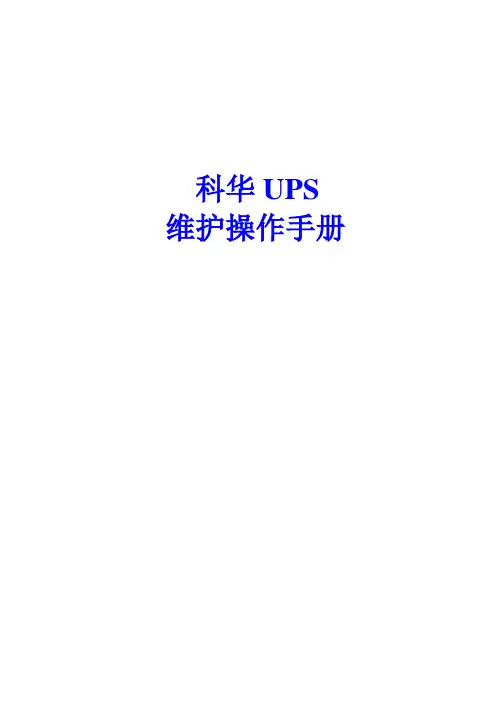
科华UPS 维护操作手册目录页码第一章概述 (3)第二章 UPS设备工作原理和技术指标一、GU1000、GU1500系列UPS基本工作原理 (4)二、GU1500系列UPS技术指标 (6)三、配置一体化工作箱的UPS系统图 (6)四、一体化蓄电池箱电池组、充电器与主机电气连接原理框图 (7)五、一体化蓄电池箱72V/5A充电器技术指标 (7)第三章 UPS设备基本面板图形一、GU1000系列面板结构 (8)二、GU1500系列面板结构 (10)三、一体化蓄电池箱结构示意图 (13)第四章 UPS设备操作步骤一、UPS开机注意事项 (15)二、UPS开机顺序 (15)三、UPS关机顺序 (15)第五章 UPS设备故障排查一、概述 (16)二、非UPS设备问题故障排查 (16)三、常见故障现象处理办法 (17)第六章UPS设备维护管理一、UPS设备维护措施 (19)二、UPS维护基本流程 (20)三、UPS运行状态资料 (21)四、UPS维护注意事项. (22)五、UPS蓄电池维护注意事项 (23)第一章概述一、随着移动通信市场的迅速发展,为适应通信网络发展的需求和节省通信投资成本,移动公司广泛采用了边际站设备。
其中华为边际站数量占据了边际站设备很大的比例,而华为边际站配套的UPS设备大都采用漳州科华公司生产的GU1000、GU1500系列UPS,后备蓄电池一般采用户外型-72V/65Ah(或72V/100Ah)蓄电池组,因此,做好科华UPS 设备的维护工作尤为重要。
二、科华GU1000、GU1500系列UPS是正弦波在线式不间断电源,是专为无线通信系统基站设计的户外型不间断电源,其在设计、安装和功能方面具有以下几点特点:1、整机设计方面,无论是UPS箱还是蓄电池箱,基本具备防尘、防水、隔热、防潮、防霉和防腐蚀等多种功能,可适用于恶劣环境条件的边远地区户外,环境适应能力较强。
2、安装结构较为灵活,UPS 可安装于墙壁上、电杆上、钢柱上和地面平台上,一体化蓄电池箱一般安装于地面或平台上。
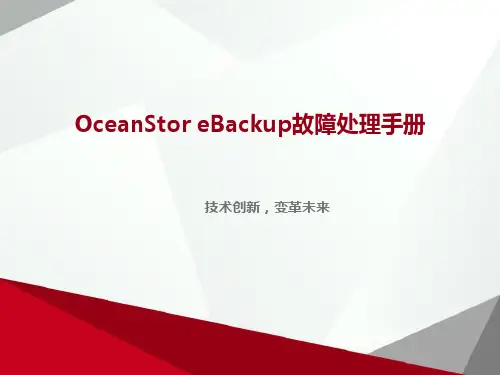
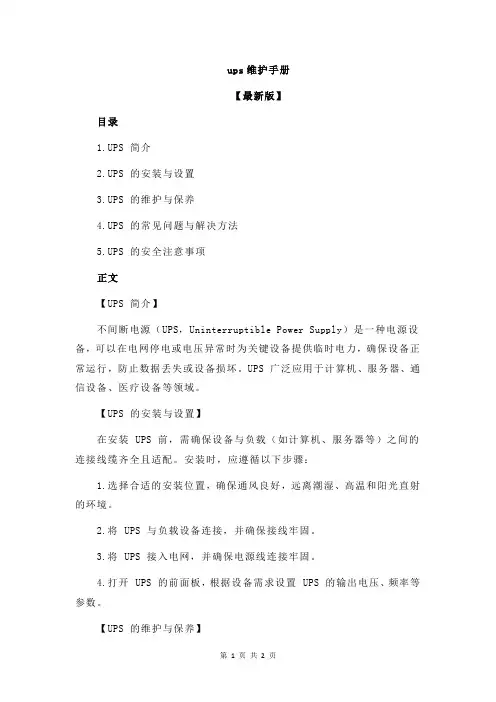
ups维护手册【最新版】目录1.UPS 简介2.UPS 的安装与设置3.UPS 的维护与保养4.UPS 的常见问题与解决方法5.UPS 的安全注意事项正文【UPS 简介】不间断电源(UPS,Uninterruptible Power Supply)是一种电源设备,可以在电网停电或电压异常时为关键设备提供临时电力,确保设备正常运行,防止数据丢失或设备损坏。
UPS 广泛应用于计算机、服务器、通信设备、医疗设备等领域。
【UPS 的安装与设置】在安装 UPS 前,需确保设备与负载(如计算机、服务器等)之间的连接线缆齐全且适配。
安装时,应遵循以下步骤:1.选择合适的安装位置,确保通风良好,远离潮湿、高温和阳光直射的环境。
2.将 UPS 与负载设备连接,并确保接线牢固。
3.将 UPS 接入电网,并确保电源线连接牢固。
4.打开 UPS 的前面板,根据设备需求设置 UPS 的输出电压、频率等参数。
【UPS 的维护与保养】为了确保 UPS 的正常运行和延长使用寿命,需要定期进行维护与保养:1.定期更换电池:根据电池的使用寿命,每 2-3 年更换一次电池。
2.清洁 UPS:使用柔软的湿布擦拭 UPS 表面,去除灰尘和污垢。
3.检查连接线:定期检查连接线是否牢固,防止接头松动导致设备损坏。
4.监控 UPS 状态:定期查看 UPS 的运行状态,确保其正常工作。
【UPS 的常见问题与解决方法】在使用 UPS 过程中,可能会遇到以下问题:1.电池寿命缩短:可能是电池质量问题或使用环境过于恶劣,需要定期更换电池并改善使用环境。
2.UPS 无法正常启动:可能是电池电量不足、电源线接触不良等原因,需要及时充电或检查接线。
3.输出电压不稳定:可能是负载波动、电网电压异常等原因,需要调整负载或联系专业人员检查电网。
【UPS 的安全注意事项】在使用 UPS 时,需注意以下几点:1.确保 UPS 安装在通风良好的环境中,防止过热导致设备损坏。
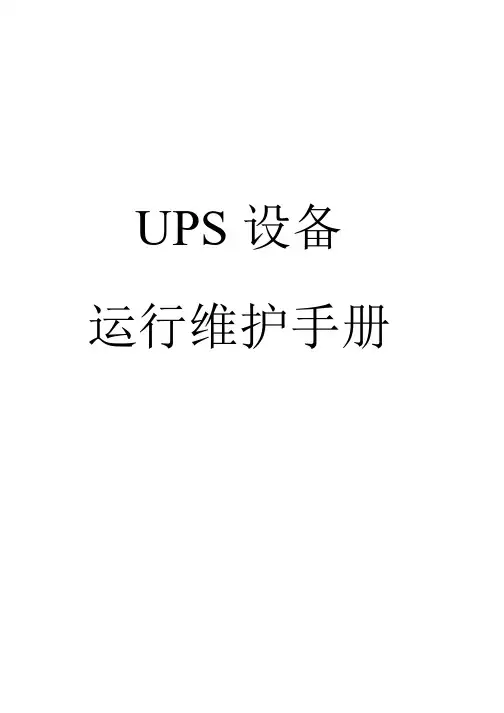
UPS设备运行维护手册设备运行维护手册索引◆安全规范◆系统总述◆设备安装◆运行模式及操控面板◆触控屏显示◆PCB功能简述◆技术规格◆选配件◆故障排除设备安全规范设备安全规范●请遵照本运行维护手册的要求操作UPS设备。
●UPS设备必须由制造商委派或授权的专业人员进行安装和维护。
●UPS内部可能存在高压,请勿擅自触碰UPS内部部件。
●安装及使用本设备请遵守相应的国家法规和行业规范。
●为保证设备运行时正常散热,请勿阻塞或将异物放置于设备通风孔或散热风道。
●请勿擅自打开UPS机箱或移除任何内部防护物,如因此而造成组件的不可修复性,制造商概不负责。
●在连接电源电缆之前,请正确连接保护接地。
●用户可通过紧急停机装置(选配件)在紧急情况下切断UPS的输出,如此时UPS设备输入断路器处于闭合状态,则UPS设备内部仍可能有高压存在。
●UPS设备内部的直流电容可能导致UPS设备内部即使在无市电输入的情况下,仍然有高压存在。
为防止发生危险,请在制造商委派或授权的专业人员指导下正确进行操作。
●请将UPS设备置于室内并保证运行环境的温度和湿度的可调控性,UPS设备连续满载运行温度必须小于40 ¡C,湿度小于95%。
目录目录1. 系统架构 (3)1.1 主要特点 (3)1.2 系统架构 (6)1.3 整流器 (6)1.4 直流系统 (7)1.5 逆变器 (7)1.6 静态切换开关 (8)1.7 维修旁路系统 (10)1.8 断路器 (12)1.9 外观及尺寸 (13)1.10 内部PCB板图解 (15)1.11 串联热备份系统(选配) (16)1.12 并联冗余系统(选配) (16)2. 设备安装 (20)2.1 物理安装 (20)2.2 场地及环境选择 (20)2.3 包装拆除 (23)2.4 线材选择 (24)2.5 端子连接 (25)2.5.1 UPS单机架构 (26)2.5.2 UPS并机架构 (28)3. 系统运行模式及操控面板 (30)3.1 操控面板 (31)3.2 系统运行模式 (33)3.2.1 正常运行模式 (33)3.2.2 后备模式 (33)3.2.3 备用电源模式 (33)3.2.4 维修旁路模式 (34)3.3 操作程序 (35)4. 触控屏显示界面 (40)4.1 能量流程 (40)4.2 运行参数 (42)4.2.1 整流器 (42)4.2.2 蓄电池 (43)4.2.3 逆变器 (43)4.2.4 静态开关 (44)4.3 系统设置 (45)4.3.2参数设置 (46)4.3.3.4密码修改 (47)4.4事件记录 (48)4.5 系统帮助 (49)5. PCB功能简述 (51)5.1 PCB简述 (51)5.2 PCB控制逻辑 (53)5.2.1 3A主机综合控制板 (53)5.2.2 3B电源控制板 (53)5.2.3 3PR并联控制板(选配件) (53)5.2.4 3T输出相位控制板 (53)5.2.5 3R通信控制板 (53)6. 技术规格 (56)6.1 20kV A~60kV A机型 (56)三相输入/单相输出三相输入/三相输出 (56)6.2 80kV A~120kV A机型 (59)三相输入/单相输出三相输入/三相输出 (59)7. 选配件 (62)7.1 充电器 (62)7.2 变送器 (62)7.3 UPSCOM TM计算机监控软件 (62)7.4可移动UPS远程操控面板 (62)8. 故障排除 (63)8.1 故障描述及解决途径 (63)1. 系统架构1. 系统架构1.1 主要特点UPS功能不间断电源设备(UPS)在现代工业应用中愈加凸现其不可替代的作用。
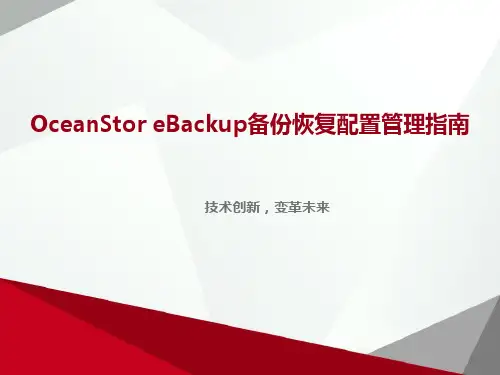
OceanStor V3系列存储系统简介快速系列文档简介如何获取帮助OceanStor5300 V3&5500 V3&5600 V3&5800 V3&6800 V3 存储系统 V300R003 快速维护指南文档版本:01发布日期:2015-08-30开始之前OceanStor V3系列存储系统是华为技术有限公司根据存储系统应用现状和未来发展趋势,开发的新一代中低端存储产品,旨在满足大中型企业用户对存储系统更高级别的性能、效率、数据安全、扩展性和管理简便性的要求。
a b 客户意见和建议c 本文档帮助您快速了解并掌握存储系统的维护手段、状态检查、故障定位和简单故障处理等工作。
更详细的操作指导请查阅《OceanStor 5300 V3&5500 V3&5600 V3&5800 V3&6800 V3存储系统 V300R003 管理员指南》。
如果您还没有华为支持帐户,请访问华为企业业务网站( )并设置一个免费帐户,以获取更多的便利,例如下载或浏览更有价值的信息,获取针对您的内容推送等。
您可以通过随设备发货的产品资料光盘,或者访问华为企业业务网站获得文档。
您的意见和建议可以帮助我们继续提高资料的准确性和整体质量。
请访问华为企业业务网站并提交您的意见和建议。
5600 V3 5800 V3 6800 V35300 V3 5500 V3如何快速维护存储系统通过下面的流程图,您可以快速了解并掌握存储系统的维护要点、异常状态处理方法等信息。
通过检查存储系统前后面板的指示灯状态,您可以了解设备的运行状态,发现和解决常见的硬件故障。
检查过程中,如果您发现状态为红色常亮或灭的指示灯,请参照附录A“指示灯异常状态速查表”进行定位和解决。
如果处理后故障依然存在,请参见第5章“收集信息并上报故障”。
存储系统指示灯及其状态组合说明如下。
1 检查存储系统指示灯状态指示灯颜色状态说明绿色橙色蓝色常亮该模块或子系统运行正常。
UPS日常使用的维护和保养1、日常维护(1)风扇: 风扇,定期检查UPS风扇运转情况,是否有风从背板吹出,对温度高的地方尤其重要。
(2)防雷器: 防雷器,检查防雷箱指示情况,防雷器外形是否正常,是否失效,接触是否良好。
2、环境(1)温度,机房温度是否高,空调是否正常,应小于40度,大于应解决。
(2)湿度,如温度大,应有抽湿设备(3)灰尘,应解决不利于UPS安全运行的因素,应该排除(4)市电,交流供电情况,有否超压、超频。
3、定期维护(1)水浸检查,防锈检查,电气检查,电气性能检查。
(2)例行功能,性能维护,根据用户手册,对系统性能功能测试,是否工作正常,检查外电池组电压。
4、定期检查(适当条件下进行)步骤如下:(1)功能验证:市电逆变→市电路旁市电逆变→关机→开机(检查故障时旁路功能)(2)市电逆变→电池逆变市电逆变→关市电→正常→加市电(检查AC/DC转换)(3)测电压,频率并逐步加载(4)电池放电检查注意:对UPS蓄电池放电检查一定要保证负载安全性前提下进行,放电检查前,确认电池已满,且负载量不低于UPS标称量30%。
5、电池保养方法(1)正常情况下,电池使用寿命为三到五年,如果发现状况不佳,则必须提早更换。
(2)更换电池时,必须由专业人员执行。
(3)更换电池时,遵循数量一致,型号一致的原则。
良好的维护和保养,可以极大地延长UPS的使用寿命。
蓄电池是UPS系统中的一个重要组成部分,它的优劣直接关系到整个UPS系统的可靠程度,然而蓄电池却又是整个UPS系统中平均无故障时间(MTBF)最短的一种器件。
所以说,对UPS的维护和保养,实际上主要就是对UPS内部的蓄电池的维护和保养。
6、UPS电池的分类蓄电池的种类一般可分为铅酸电池、铅酸免维护电池及镍镉电池等,它们各自的特点如下:(1)铅酸电池/一般型电池,也称为汽车用电池/需加水维护,期望寿命1~3年,充放电时会产生氢气,安置地点须设置排风管以免造成危险;电解液呈酸性,会腐蚀金属;价格低廉。
OceanGuard TM Operations & Maintenance ManualTable of ContentsIntroduction (2)Why do I need to perform maintenance? (2)Health and Safety (3)Personnel health and safety (3)How does it Work? (4)Maintenance Procedures (4)Primary Types of Maintenance (4)Minor Service (5)Hand Maintenance (5)Vacuum Maintenance (5)Major Service (Filter Bag Replacement) (5)Additional Reasons of Maintenance (6)Hazardous Material Spill (6)Blockages (6)Major Storms and Flooding (6)Disposal of Waste Materials (6)Maintenance Services (6)Rev: 1 Last Updated: March 2019IntroductionThe primary purpose of stormwater treatment devices is to capture and prevent pollutants from entering waterways, maintenance is a critical component of ensuring the ongoing effectiveness of this process. The specific requirements and frequency for maintenance depends on the treatment device and pollutant load characteristics of each site. This manual has been designed to provide details on the cleaning and maintenance processes as recommended by the manufacturer.The OceanGuard technology is a gully pit basket designed to fit within new and existing gully pits to remove pollution from stormwater runoff. The system has a choice of Filtration liners, designed to remove gross pollutants, total suspended solids and attached pollutants as either a standalone technology or as part of a treatment train with our StormFilter or Jellyfish Filtration products. OceanGuard pit baskets are highly effective, easy to install and simple to maintain.Why do I need to perform maintenance?Adhering to the maintenance schedule of each stormwater treatment device is essential to ensuring that it functions properly throughout its design life.During each inspection and clean, details of the mass, volume and type of material that has been collected by the device should be recorded. This data will assist with the revision of future management plans and help determine maintenance interval frequency. It is also essential that qualified and experienced personnel carry out all maintenance (including inspections, recording and reporting) in a systematic manner. Maintenance of your stormwater management system is essential to ensuring ongoing at-source control of stormwater pollution. Maintenance also helps prevent structural failures (e.g. prevents blocked outlets) and aesthetic failures (e.g. debris build up), but most of all ensures the long term effective operation of the OceanGuard.Health and SafetyAccess to pits containing an OceanGuard typically requires removing (heavy) access covers/grates, but typically it is not necessary to enter into a confined space. Pollutants collected by the OceanGuard will vary depending on the nature of your site. There is potential for these materials to be harmful. For example, sediments may contain heavy metals, carcinogenic substances or sharp objects such as broken glass and syringes. For these reasons, there should be no primary contact with the waste collect and all aspects of maintaining and cleaning your OceanGuard require careful adherence to Occupational Health and Safety (OH&S) guidelines.It is important to note that the same level of care needs to be taken to ensure the safety of non-work personnel, as a result it may be necessary to employ traffic/pedestrian control measures when the device is situated in, or near areas with high vehicular/pedestrian activity.Personnel health and safetyWhilst performing maintenance on the OceanGuard pit insert, precautions should be taken in order to minimise (or when possible prevent) contact with sediment and other captured pollutants by maintenance personnel. In order to achieve this the following personal protective equipment (PPE) is recommended: ∙Puncture resistant gloves∙Steel capped safety boots,∙Long sleeve clothing, overalls or similar skin protection∙Eye protection∙High visibility clothing or vestDuring maintenance activities it may be necessary to implement traffic control measures. Ocean Protect recommend that a separate site specific traffic control plan is implemented as required to meet the relevant governing authority guidelines.The OceanGuard pit insert is designed to be maintained from surface level, without the need to enter the pit. However depending on the installation configuration, location and site specific maintenance requirements it may be necessary to enter a confined space occasionally. It is recommended that all maintenance personnel evaluate their own needs for confined space entry and compliance with relevant industry regulations and guidelines. Ocean Protect maintenance personnel are fully trained and carry certification for confined space entry.How does it Work?OceanGuard is designed to intercept stormwater as it enters the stormwater pits throughout a site. The OceanGuard has diversion panels that sit flush with the pit walls, this ensures that as stormwater enters at the top of the pit it is directed to the middle of the insert where the Filtration bag is situated. The filtration bag allows for screening to occur removing 100% of pollutants greater than the opening of the filtration material (200micron, 1600micron bags available).During larger rain events the large flows overflow slots in the flow diverter of the OceanGuard ensure that the conveyance of stormwater is not impeded thus eliminating the potential for surface flooding. As the flow subsides, the captured pollutants are held in the OceanGuard Filtration bag dry. The waste then starts to dry which reduces the magnitude of organic material decomposition transitioning between maintenance intervals.Maintenance ProceduresTo ensure that each OceanGuard pit insert achieves optimal performance, it is advisable that regular maintenance is performed. Typically the OceanGuard requires 2-4 minor services annually, pending the outcome of these inspections additional maintenance servicing may be required.Primary Types of MaintenanceThe table below outlines the primary types of maintenance activities that typically take place as part of an ongoing maintenance schedule for the OceanGuard.Description of Typical Activities FrequencyMinor Service Filter bag inspection and evaluationRemoval of capture pollutantsDisposal of material2-4 Times AnnuallyMajor ServiceFilter Bag ReplacementSupport frame rectificationAs requiredMaintenance requirements and frequencies are dependent on the pollutant load characteristics of each site. The frequencies provided in this document represent what the manufacturer considers to be best practice to ensure the continuing operation of the device is in line with the original design specification.Minor ServiceThis service is designed to return the OceanGuard device back to optimal operating performance. This type of service can be undertaken either by hand or with the assistance of a Vacuum unit.Hand Maintenance1.Establish a safe working area around the pit insert2.Remove access cover/gratee two lifting hooks to remove the filtration bag4.Empty the contents of the filtration bag into a disposal container5.Inspect and evaluate the filtration bag6.Inspect and evaluate remaining OceanGuard components(i.e. flow diverter, filtration cage and supporting frame)7.Rejuvenate filtration bag by removing pollutant build up with a stiff brush, additionally the filtrationbag can be washed using high pressure water8.Re-install filtration bag and replace access cover/grateVacuum Maintenance1.Establish a safe working area around the pit insert2.Remove access cover/grate3.Vacuum captured pollutants from the filtration bag4.Remove filtration bag5.Inspect and evaluate the filtration bag6.Inspect and evaluate remaining OceanGuard components(i.e. flow diverter, filtration cage and supporting frame)7.Rejuvenate filtration bag by removing pollutant build up with a stiff brush, additionally the filtrationbag can be washed using high pressure water8.Re-install filtration bag and replace access cover/grateMajor Service (Filter Bag Replacement)For the OceanGuard system, a major service is a reactionary process based on the outcomes from the minor service.Trigger Event from Minor Service Maintenance ActionFiltration bag inspection revealsdamageReplace the filtration bag[1]Component inspection reveals damage Perform rectification works and if necessary replace components[1][1] Replacement filtration bags and components are available for purchase from Ocean Protect.Additional Reasons of MaintenanceOccasionally, events on site can make it necessary to perform additional maintenance to ensure the continuing performance of the device.Hazardous Material SpillIf there is a spill event on site, all OceanGuard pits that potentially received flow should be inspected and cleaned. Specifically all captured pollutants from within the filtration bag should be removed and disposed in accordance with any additional requirements that may relate to the type of spill event. All filtration bags should be rejuvenated (replaced if required) and re-installed.BlockagesThe OceanGuards internal high flow bypass functionality is designed to minimise the potential of blockages/flooding. In the unlikely event that flooding occurs around the stormwater pit the following steps should be undertaken to assist in diagnosing the issue and implementing the appropriate response.1.Inspect the OceanGuard flow diverter, ensuring that they are free of debris and pollutants2.Perform a minor service on the OceanGuard3.Remove the OceanGuard insert to access the pit and inspect both the inlet and outlet pipes, ensuringthey are free of debris and pollutantsMajor Storms and FloodingIn addition to the scheduled activities, it is important to inspect the condition of the OceanGuard pit insert after a major storm event. The inspection should focus on checking for damage and higher than normal sediment accumulation that may result from localised erosion. Where necessary damaged components should be replaced and accumulated pollutants disposed.Disposal of Waste MaterialsThe accumulated pollutants found in the OceanGuard must be handled and disposed of in a manner that is in accordance with all applicable waste disposal regulations. When scheduling maintenance, consideration must be made for the disposal of solid and liquid wastes. If the filtration bag has been contaminated with any unusual substance, there may be additional special handling and disposal methods required to comply with relevant government/authority/industry regulations.Maintenance ServicesWith over a decade and a half of maintenance experience Ocean Protect has developed a systematic approach to inspecting, cleaning and maintaining a wide variety of stormwater treatment devices. Our fully trained and professional staff are familiar with the characteristics of each type of system, and the processes required to ensure its optimal performance.Ocean Protect has several stormwater maintenance service options available to help ensure that your stormwater device functions properly throughout its design life. In the case of our OceanGuard system we offer long term pay-as-you-go contracts, pre-paid once off servicing and replacement filter bags.For more information please visit .au。
oceanstor使用手册
OceanStor是华为公司的存储产品线之一,包括多种存储设备和解决方案。
由于具体的OceanStor产品和版本可能有所不同,使用手册将取决于您所使用的具体产品型号和软件版本。
以下是一个通用的OceanStor使用手册大纲,供您参考:
OceanStor使用手册
1.产品概述
介绍OceanStor存储产品线的特点和优势
详细说明您所使用的具体OceanStor设备的型号和配置
2.硬件设置和安装
设备的安装和部署
连接存储设备到网络和服务器
配置存储设备的硬件参数
3.存储管理
存储资源管理和分配
卷管理和卷创建
快照管理
存储池管理
4.数据备份和恢复
数据备份策略设置
数据复制和灾难恢复
数据恢复操作
5.性能优化和监控
存储性能监控
存储性能优化策略
告警和事件管理
6.安全性和权限控制
存储数据的安全性措施
权限控制和访问管理
安全审计
7.软件升级和维护
软件版本升级
存储设备的日常维护
故障排除和支持
8.教育和培训
存储管理和操作的培训资源在线教育和认证课程
9.支持和技术服务
联系技术支持和客户服务常见问题解答
维修和保修政策
10.附录
相关文档、资源和链接
术语和缩写词表
请注意,OceanStor存储产品线包括多种不同类型的存储设备,例如块存储、文件存储、对象存储等,因此使用手册的内容和细节可能会根据您所使用的具体产品而有所不同。
建议您在使用手册之前查阅相关文档和技术资源,以确保您能够正确地配置和操作OceanStor 设备。
UPS日常维护与管理1 操作使用与维护中的注意事项①UPS实际可带的负载量与负载的功率因数有关,负载为纯阻性或纯感性负载时,它实际允许的输出功率都小于其标称的输出功率。
UPS不宜带电感性负载。
②UPS的输出端不宜带可控硅类或半波整流型负载,若在实际工作中确需带此类负载时,可采取适当的缓解措施。
如增大UPS的额定输出功率、增加或改变负载中阻性负载与感性负载之间的比例,或者直接在UPS输出端与负载之间加入隔离变压器和输入输出滤波装置等。
③后备式UPS的前级不宜增添带有大电抗元件的交流稳压器,因为它会使市电供电与逆变器供电之间的转换时间加长,极有可能造成微机系统在运行中产生错误的自检启动动作,易破坏微机内正运行的软件。
在线式UPS在前级增添交流稳压器(如净化电源),则可确保其在执行市电旁路供电与逆变器供电转换时的同相、同频、同幅,从而安全切换成功,这也是与后备式UPS之间有较大差异的地方。
④在线式UPS带负载工作情况下,若将UPS作为开关来直接进行开、停机,易在带载启动或停机时烧毁逆变器的功率开关器件。
特别是在以功率MOS管作功率开关器件的UPS中,对于具有延迟启动功能,但采用可控硅静态开关来作为市电供电和逆变器供电的转换开关的UPS来说,当市电质量太差或市电起伏过大时,其带载的开机或停机都易造成设备的故障发生。
无论是在线式还是后备式UPS,都应尽量减小无为的开停机次数,降低人为因素的故障发生率。
⑤使用可控硅作静态开关的小型UPS虽已采用了市电同步锁相技术,但一般没有设置同步转换条件判别电路,因此在实际执行切换时,可能会出现电源“反灌”现象而烧毁逆变器末级功率开关器件或损坏静态转换开关。
为解决这一问题,常将逆变器的输出电压调得略高于旁路电源电压。
⑥UPS工作在相互干扰较重的电网中时,易出现:◇由电网的零线串入的干扰引起UPS电源的控制电路误动作。
◇不加交流稳压电源的UPS产生频繁或错误的切换。
◇对于那些具有同步锁相功能的在线式UPS来说,易使同步回路反复处于市电强制同步和失锁不同步的切换状态中,从而致使同步回路输出的脉冲序列产生强烈的相位摆动。